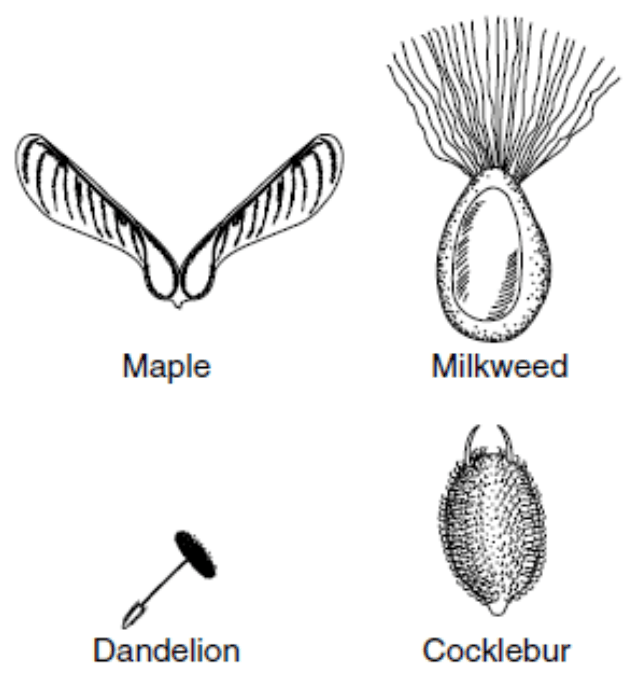Which of these is a function of a leaf?
a. Carrying nutrients throughout the plant
b. Converting solar energy into sugar
c. Creating shade for the plant
d. Absorbing water from the ground
b. Converting solar energy into sugar
Which of these plant parts forms the seeds?
a. The stamen
b. The pistil
c. The sepals
d. The petals
b. The pistil
What do ferns have that apple trees do not have?
a. pistils
b. anthers
c. spores
d. seeds
c. spores
Plates that move together are called -
a. divergent boundaries
b. convergent boundaries
c. transform boundaries
d. erosion
b. convergent boundaries
A Virginia natural resource important to the state’s economy, as well as a primary source of energy, is —
a. oil
b. steel
c. coal
d. limestone
c. coal
In a flower, what most likely happens when pollen from the stamen gets into the ovary?
a. The plant dies.
b. A seed develops.
c. The flower closes.
d. The sepals fall off.
b. A seed develops.
Which of the following do plants need to make their own food?
a. Flowers
b. Bacteria
c. Sunlight
d. Oxygen
c. Sunlight
Which of the following is a benefit that many flowering plants get from animals?
a. Shelter from direct sunlight
b. Seeds carried to new places
c. Oxygen to use in photosynthesis
d. Moisture to prevent wilting
b. Seeds carried to new places
Plates that slip past each other are called -
a. divergent boundaries
b. convergent boundaries
c. transform boundaries
d. erosion
c. transform boundaries
Which of these is a natural resource of Virginia?
a. A dam
b. A glacier
c. A river
d. A power plant
c. A river
Which part of a sunflower plant absorbs water and nutrients?
a. Roots
b. Stems
c. Leaves
d. Flowers
a. Roots
Photosynthesis occurs in which of these organisms?
a. Sunflower
b. Mushroom
c. Sunfish
d. Luna
a. Sunflower
The wind helps many plants reproduce by —
a. cooling the plants
b. giving the plants moisture
c. spreading the plants’ pollen
d. strengthening the plants’ root systems
c. spreading the plants’ pollen
Plates that move apart are called -
a. divergent boundaries
b. convergent boundaries
c. transform boundaries
d. erosion
a. divergent boundaries
Which of the following is a common plant that grows wild in Virginia?
a. Orange tree
b. Cactus tree
c. Lemon tree
d. Dogwood tree
d. Dogwood tree
The two structures most plants use to gather nutrients and energy to live are —
a. roots and leaves
b. roots and flowers
c. stems and roots
d. stems and leaves
a. roots and leaves
The substance that makes plants green is known as -
a. water
b. calcium
c. chlorophyll
d. carbon dioxide
c. chlorophyll
One way that mosses and ferns are similar is they both -
a. are flowering plants
b. produce spores
c. grow in areas with little rainfall
d. are dormant during the winter
b. produce spores
When pressure builds between two tectonic plates, it can suddenly release causing a (an) ______________________
a. Hurricanes
b. Floods
c. Tornadoes
d. Earthquakes
d. Earthquakes
Which of these is the most important product of Virginia forests?
a. Pecan trees
b. Pine cones
c. Hardwood lumber
d. Maple leaves
c. Hardwood lumber
Pollen is produced in the —
a. ovary
b. pistil
c. petal
d. stamen
d. stamen
Why is photosynthesis important for plants?
a. It collects sunlight which is used to make food for plants.
b. It gets rid of plant waste products.
c. It changes plant sugar into stronger chemicals.
d. It helps attract insects to plant flowers.
a. It collects sunlight which is used to make food for plants.
Which of the following seeds is probably carried by animals?
a. Maple b. Dandelion c. Milkweed d. Cocklebur

d. Cocklebur
Divergent plate movement can create -
a. convection currents
b. mountains
c. rifts and ocean ridges
d. conduction
c. rifts and ocean ridges
The Chesapeake Bay is important to the larger ocean ecosystem because —
a. it is the largest habitat for blue crabs in the United States
b. it provides spawning grounds, nursery beds, and feeding grounds for many species of ocean creatures
c. it serves as the winter home for tundra swans, Canada geese, and a variety of other ducks
d. some species of freshwater fish come down from the rivers to spawn in the bay
b. it provides spawning grounds, nursery beds, and feeding grounds for many species of ocean creatures